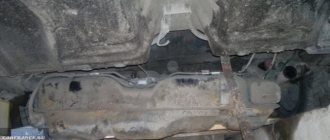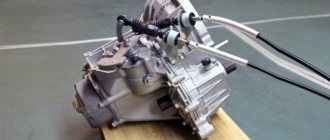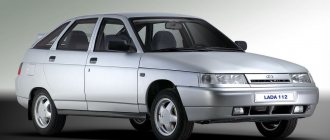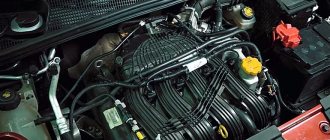Not so long ago, AvtoVAZ manufacturers released an improved Lada-Kalina automatic. In principle, the robotic box is the main modified unit. Only variants with a 1.6-liter power unit with a capacity of 98 “horses” are equipped with such a transmission. In terms of body style, the choice will be somewhat wider: hatchback or station wagon. Let's consider the features of this car, its characteristics, owner reviews, as well as behavior on the road.
Characteristics
Before purchasing a Lada-Kalina automatic, do not forget to familiarize yourself with the nuances of its design. Firstly, due to the different configurations of the main unit of a manual and robotic transmission, the automatic transmission will take up much more space. This was reflected in the ground clearance, which decreased by 20 mm compared to its analogue with the usual “mechanics”. Secondly, on the modification under consideration the pan is not made of steel, but of an aluminum alloy. When hitting an uneven road, the steel part will simply be scratched or receive a small dent.
The aluminum pan can burst even from a slight mechanical impact, leaving the motor unprotected. In addition, if the impact is significant, the engine may be damaged immediately. After purchasing the car in question, experts strongly recommend replacing the pan with a more durable version. By spending a small amount, you will insure yourself against expensive repairs or replacement of the power plant.
Results
Let's summarize. Lada Kalina with automatic transmission is a pretty good choice. Even if you compare it with other cars with a manual transmission, it will have some advantage.
For example, there are often road surfaces that have a large number of holes, potholes and uneven surfaces. On a manual transmission, this immediately causes discomfort, since you first need to reduce the speed and then increase it back, while working with your left foot on the clutch and your right hand on the shift lever. In turn, the automatic transmission allows you to perform this maneuver with just one movement of your foot, moving it from the gas pedal to the brake pedal, and vice versa.
The disadvantages of this box, which we listed earlier, are divided into significant and insignificant. For example, an aluminum engine sump. In general, this is a serious problem, but it can be solved quite simply. It is enough to simply replace the pallet with a steel one. But the problem with increased fuel consumption is no longer so easily solved, or rather, not solved at all. But it’s customary to pay for comfort, so if you choose a car with an automatic transmission, then get ready for additional expenses.
Automatic transmission parameters
The Lada-Kalina 2 car is equipped with an automatic transmission from Japanese (Jatco). Let's try to compare this part with a mechanical analogue, identifying all the existing pros and cons.
For example, the acceleration rate of the “robot” slowed down to 13.7 seconds/100 km. The manual transmission is a little faster – 11.2 or 12.4 seconds to “hundreds”, depending on engine power. It is worth noting that in the city such a difference will not be noticeable, but on the highway it will be completely absent.
The fuel consumption of the Lada-Kalina automatic was 7.8 liters, and in the city it was about 10 liters per 100 km. At the same time, the mechanical analogue “eats” 7 l/100 km (with an eight-valve 87-horsepower engine). A more powerful modification with 106 “horses” consumes 6.7 l/100 km. However, you should not make rash and hasty negative conclusions in the direction of automatic transmission. It is worth considering that with a manual transmission it is necessary to make an effort and spend time activating the clutch pedal and engaging the gear. Since this is not required on an automatic transmission, the starting acceleration is practically equalized.
"Lada-Kalina" automatic: reviews
Owners of the car in question note a number of shortcomings that are most often encountered when operating this model. This includes:
- Directly gearbox. The very inclusion of speeds does not cause any particular complaints; the lever confidently falls into place in any mode. However, installing the handle in an intermediate position is a challenge. For some reason these positions are not felt. In this regard, it is easy to miss them and the car will be “at speed” again.
- The brake and gas pedals are placed too close. When you click on one of them, you can easily hook the second element, even if not to the point of full activation, but this causes certain inconveniences.
In addition, owners of Lada-Kalina 2 have a problem with the Check Engine indicator flashing while driving. In this case, the vehicle behaves without any reaction to the signal. Experts advise solving the problem by removing the terminal for a few minutes. Most likely, the reason lies in a banal system error. Sometimes the light bulb turns off on its own after a certain time.
Change of oil
Also, in addition to the need to repair the entire structure of the automatic transmission, there may be a problem with changing the oil in the unit. At the same time, despite the manufacturer’s assurances that the oil in such boxes does not need to be changed, by the end of the first hundred thousand kilometers the transmission fluid becomes contaminated.
Another erroneous belief is that automatic transmissions are unpretentious to any type of oil. It is worth noting that this belief is only half true. So, for example, if you choose a low-quality oil, the mechanical components of the gearbox, as well as its valve body, will be practically unaffected. But a problem may arise with further operation of the solenoids - valves of the valve body.
When using low-quality or unsuitable oil for a given gearbox, the valves begin to oxidize, which can subsequently lead to interruptions in their operation. The problem can be detected during vehicle diagnostics.
"Lada-Kalina" automatic: test drive
The driver’s sensations when operating this car will largely depend on which car the person is changing from. If this is a VAZ “mechanics”, there will be positive emotions only from the fact that he will not need to pull the shift lever. In addition, he will not be bothered by the squealing of gears, which is less on an automatic machine due to processes optimized by the robot.
The driver will not be confused by the lack of “parking” and “drive” positions. Auto, the algorithm for turning on the engine is simple. Despite the absence of a recoil mechanism, this will not present any special problems, since the domestic “mechanics” do not have it either. But for a user who is accustomed to a foreign car with a classic automatic transmission, all these moments will not bring much joy.
Replacing wiring
Another problem that can lead to automatic transmission repair is the occurrence of faults in the wiring. Among the most common causes of such malfunctions are:
- Oxidation of contacts.
- Deterioration of wire insulation as a result of their damage.
- Broken wires or connecting clamps.
In any case, all causes can be corrected quite easily, especially if the location and extent of the breakdown is determined in a timely manner. Most repairs are carried out by professionals who are able to organize safe work with electrical wires. An attempt to eliminate the cause of the breakdown on your own, in the absence of proper knowledge, can only aggravate the situation and lead to a malfunction of any device, sensor or entire system.
What common?
The Lada-Kalina automatic is often criticized for the time it takes to change gears. This is not surprising, since the mechanism used is a real robot, and not of the highest quality.
When controlling the AMT, instead of a lever switch, a pair of actuators are introduced (for squeezing the clutch and changing gears). In addition, there is an electronic unit that was used on the G8 (with elements from German manufacturers). This unit turned out to be quite worthy of respect, as most experts agree.
We continue to compare AMT and automatic transmission
When choosing what is better for the Lada Kalina - an automatic or a robot, it is worth noting that the AMT version with five ranges has proven to be one of the most successful modifications. The robot functions more delicately than most Japanese or French counterparts. However, design features affect the noticeability of gear changes, which is most noticeable during active acceleration.
In comparison runs during test trials, it was clear that Kalina was a little faster than the model with an automatic transmission. True, this gap was only 0.2 tenths of a second, while acceleration with an automatic transmission was smoother and more pleasant to feel. The moment the gear is engaged on the Lada-Kalina, the automatic transmission is somewhat lubricated, which is due to the presence of oil operating in the transformer. AMT simply does not provide such a system.
Replacing the valve body
Finally, the last reason for the occurrence of problems during the operation of an automatic transmission may be a malfunction of the valve body. The problem may arise due to contaminants that accumulate during the operation of the vehicle. And the repair will consist of cleaning the valve body with special means.
Thus, the automatic transmission on the Lada Kalina is quite an effective, but at the same time, expensive unit, which will not only increase the cost of operating the vehicle, but will also cause dissatisfaction among the owners due to frequent breakdowns during improper operation of the car.
Interesting observations
One of the features of the test drive in question is that a girl who had previously driven an automatic was put behind the wheel of a modification with AMT. She immediately noticed several differences, namely:
- “Robot” is sharp at the start.
- It's noisier.
- There is no “creeping” transmission mode.
It is also worth noting the moments of switching, the inconvenience of which can only be detected during maximum acceleration and spurt. Since 99% of drivers do not have such a driving style, and it is only needed during testing, you can safely turn a blind eye to this.
How does the automatic transmission behave?
Many users note in their reviews that it makes no sense to get used to an outdated, albeit automatic, modification of the gearbox if it does not differ much in its operation from the AMT. But the Jatko box has a lot of advantages. Firstly, it shifts smoother, although slower than a modern AMT. Secondly, this is a completely imported unit. However, it is more expensive and requires an additional cooling system and original wheel drives during installation. For comparison: AMT consists of almost 80% domestic parts. As a result, the price of the Lada Kalina automatic increases by at least 25 thousand rubles.
The main problem with the Jatco automatic transmission is fuel consumption. In the city in the off-season, taking into account traffic jams, slipping, and frequent stops, the automatic transmission will “eat up” from 11.5 to 12.5 liters per hundred kilometers, depending on driving style. Under similar conditions, a car with AMT consumes about 8.5 l/100 km.
DIY replacement
If necessary, you can replace the automatic transmission yourself. To do this, you will need to stock up on the necessary tools, as well as purchase a new gearbox.
The sequence of actions for self-replacement is presented below:
- First of all, you will need to disconnect the terminals from the battery and open the hood completely.
- Next will be dismantling the oil filler cap. In addition, it is necessary to remove the damaged gearbox, loosen the fixing clamp and disconnect the sensors connected to it. You will also need to disconnect the intake pipe hose.
- The final action will be to replace the automatic transmission by installing the unit in place of the one that was dismantled. Additionally, lubricant is applied to the surface of the gearbox to increase the life of the parts included in the structure, and the front part of the car is reassembled in the reverse order.
As a rule, the cost of automatic transmission repair in Lada Kalina depends on what type of work will be carried out: partial or major. Undoubtedly, it is more profitable to repair a gearbox, since a new or used gearbox costs a lot of money.
Thus, the cost of a used automatic transmission varies from 30,000 to 50,000 rubles (taking into account delivery distance, etc.). The price of a new automatic transmission for the Lada Kalina ranges from 70,000-90,000 rubles.
Tests on the track
The Lada-Kalina automatic station wagon was also tested directly on the track. The driver reset the readings and drove along the road where the above tests were carried out. Now he tried to make the most of it, overtook everyone he could, brake sharply in front of slow-moving cars, and sharply turned on the gas again. After such differences at the finish line, the fuel consumption figure was 8.5 liters per 100 kilometers. With absolutely identical behavior of the car with the “robot”, the same figure was a record 5.8 l/100 km.
It is worth noting that there is no significant difference in the price of maintenance between different transmissions. But it is noticeable when servicing 8 and 16 valve power units. In the second option, the first maintenance is not required at all, since there is no need to adjust the valves.
Another point that should be noted when testing Kalina with an automatic transmission is engine braking. Both cars were tested (AMT and automatic transmission). For long descents, the Jatko has fixed 2nd and 1st gears. But on the approaches to icy intersections I had to suffer quite a bit before finding the desired mode, and even then, thanks to ABS, EBD and other bells and whistles.
With an automatic transmission, getting into fixed gears in this situation is not the most pleasant test for the driver’s nervous system. With a robotic gearbox, everything is much simpler - you just need to move the lever to the “manual”, then pump it a couple of times, and the car is already driving in second, not fourth, speed.
Problems that may arise when using automatic transmission
First of all, it should be noted that every 80 thousand kilometers it is necessary to replace the oil that maintains the functionality of the engine and gearbox components.
It is also recommended to overhaul the robotic gearbox after the car has traveled approximately 250-300 thousand km.
If you treat the operation of the vehicle negligently, without regularly inspecting the vehicle’s components and timely replacement of fluids, parts or devices, this can lead to rapid failure of the automatic transmission. As a result of such an attitude, the clutches will quickly burn out and the valve body responsible for the operation of the box will fail. Thus, further work will become impossible.











